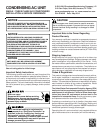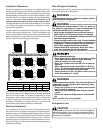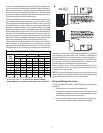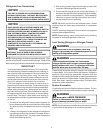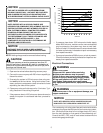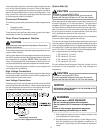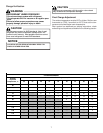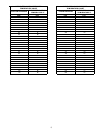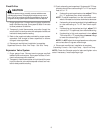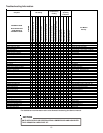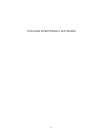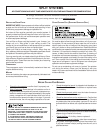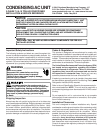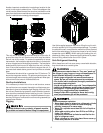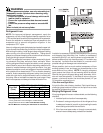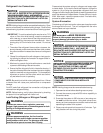
3
Use only refrigerant grade (dehydrated and sealed) copper tub-
ing to connect the condensing unit with the indoor evaporator.
After cutting the tubing, install plugs to keep refrigerant tubing
clean and dry prior to and during installation. Tubing should
always be cut square keeping ends round and free from burrs.
Clean the tubing to prevent contamination.
Do NOT let refrigerant lines come in direct contact with plumb-
ing, ductwork, floor joists, wall studs, floors, and walls. When
running refrigerant lines through a foundation or wall, openings
should allow for sound and vibration absorbing material to be
placed or installed between tubing and foundation. Any gap
between foundation or wall and refrigerant lines should be filled
with a pliable silicon-based caulk, RTV or a vibration damping
material. Avoid suspending refrigerant tubing from joists and
studs with rigid wire or straps that would come in contact with
the tubing. Use an insulated or suspension type hanger. Keep
both lines separate and always insulate the suction line.
These sizes are recommended for line lengths of 79 feet or
less. For other line sizing option or runs of more than fifty feet,
refer to Remote Cooling Service Manual, or TP-106 Long Line
Set Application R-22, or contact your distributor for assistance.
Cond
Unit
Tons Suct Liq Suct Liq Suct Liq
1 1/2 5/8 1/4 3/4 3/8 3/4 3/8
2 5/81/43/43/83/43/8
2 1/2 5/8 1/4 3/4 3/8 7/8 3/8
3 3/4 3/8 7/8 3/8 1 1/8 3/8
3 1/2 7/8 3/8 1 1/8 3/8 1 1/8 3/8
4 7/8 3/8 1 1/8 3/8 1 1/8 3/8
5 7/8 3/8 1 1/8 3/8 1 1/8 3/8
Line Diameter (In. OD)
RECOMMENDED INTERCONNECTING TUBING (Ft)
0-24 25-49 50-79*
* Lines greater than 79 feet in length or vertical elevation
changes more than 50 feet
refer to the Remote Cooling
Service Manual or contact your distributor for assistance.
Insulation is necessary to prevent condensation from forming
and dropping from the suction line. Armflex (or satisfactory
equivalent) with 3/8” min. wall thickness is recommended. In
severe conditions (hot, high humidity areas) 1/2” insulation may
be required. Insulation must be installed in a manner which
protects tubing from damage and contamination.
Where possible, drain as much residual compressor oil from
existing systems, lines, and traps; pay close attention to low
areas where oil may collect.
NOTE: If changing refrigerant types, ensure the indoor coil and
metering device is compatible with the type of refrigerant being
used; otherwise, the indoor coil must be replaced.
Burying Refrigerant Lines
If burying refrigerant lines can not be avoided, use the following
checklist.
1. Insulate liquid and suction lines separately.
2. Enclose all underground portions of the refrigerant lines
in waterproof material (conduit or pipe) sealing the ends
where tubing enters/exits the enclosure.
3. If the lines must pass under or through a concrete slab,
ensure lines are adequately protected and sealed.



